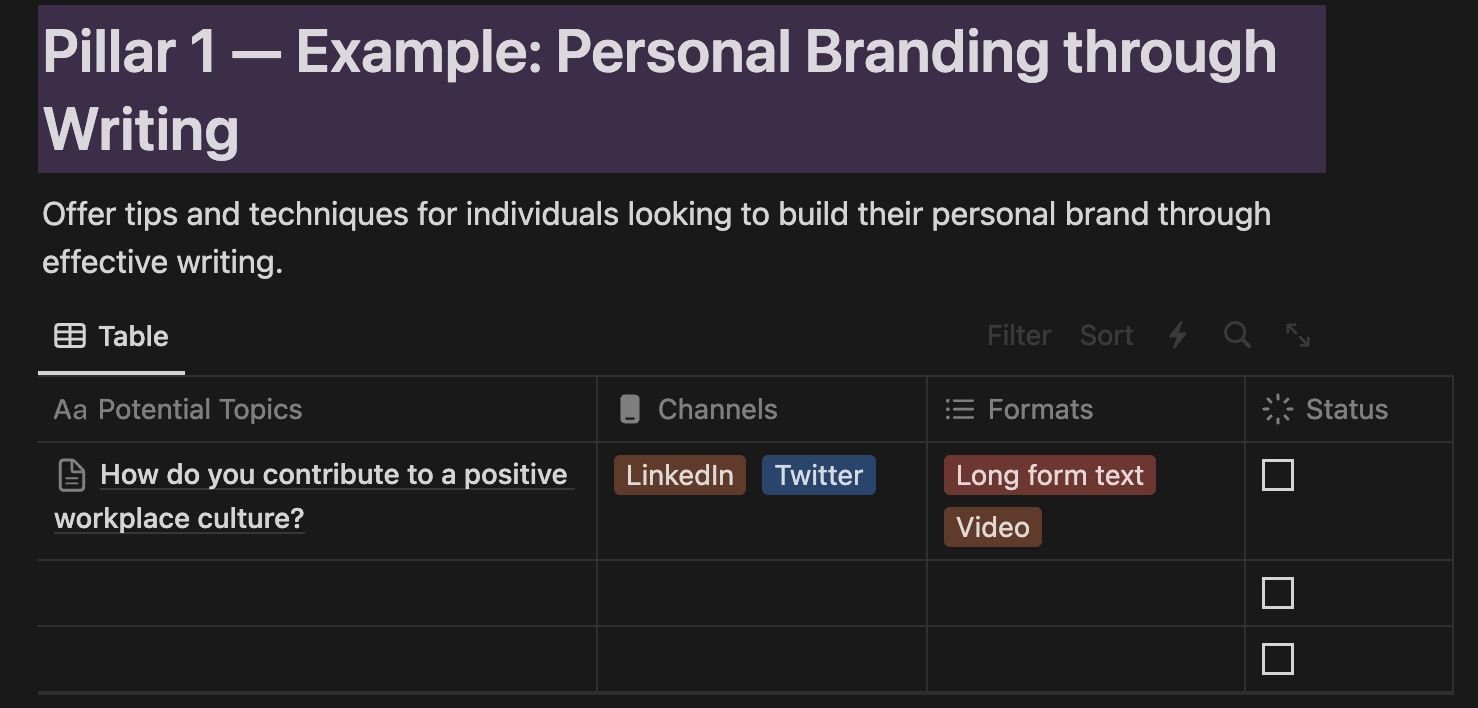Thanks to ever-changing social media algorithms and the ever-growing list of platforms that make them, it’s easier than ever to become a creator. However, because anyone can become a creator, there’s also more noise than ever for your potential audience to cut through. So, while it’s great (and ideal) to build a platform off your personality, it’s not the most realistic method.
What is realistic, is niching down – that is, pick a topic (or set of topics) and build your content around them. And how can you do this? With content pillars.
I’ve written about content pillars before and wanted to bring my systems and thoughts to the Buffer audience. In this article, we’ll dive into what content pillars are, why they’re important, and how to develop them for yourself.
What is a content pillar?
A content pillar is a key theme or topic you want to focus on in your content and become known to your audience on social media. Most creators have a combination of several pillars that form the foundation of their content strategy.
Content pillars ensure you can control “what you’re known for” to a certain degree and help determine how people define your content when explaining it to others.
Why are content pillars important for social media?
Developing content pillars achieves several goals for creators. One is that many platforms, from Twitter to TikTok, categorize content in their search engines. If you define content pillars and create according to them, you can better control how you appear in search engines by creating to match certain categories and keywords relevant to your content.
Also, no matter your reasons for focusing on social media, you probably want to achieve one or more of these five things:
- Promote
- Educate
- Engage
- Inspire
- Entertain
With content pillars, you can structure whichever of these goals matches what you try to achieve in your creative process.
Content pillars are also a constant source of inspiration – when you know the broad strokes of what you want to say, you can continuously and consistently generate ideas with fewer gaps or blocks in between.
Examples of content creators with clear content pillars
Content pillars are the backbone for creators looking to build a consistent brand narrative. Here's how some notable content creators have used this concept to carve out their unique identity.
Dulma Altan
Content pillars: Creator economy, tech, startups, and venture capital
Dulma Altan's venture into podcasting was a natural extension of her TikTok presence, where she explored topics revolving around the creator economy, tech, startups, and venture capital. Her approach centered around translating short-form content into longer, more in-depth discussions on her podcast.
@iamdulma Publish content people would miss
♬ original sound - Dulma 🦋
Using her network, she invited various guests, enriching her content and providing different perspectives to her audience. Her key takeaway is to create content you wish existed, adding unique value to the audience.
Dre Fox
Content pillars: Solopreneurship, content creation, business coaching
With her innovative 'Content Tree' method, Dre Fox takes the conventional three-to-five-pillar model and expands it into many sub-topics. This branching out helps her avoid repetitive content and allows more dynamic engagement with the audience.
Her method involves an intuitive match between the topic and the visual medium, be it a carousel for step-by-step guides, personal photos for storytelling, or videos for trendier, light-hearted content.
Joy Ofodu
Content pillars: Comedy, dating, wellness
Joy Ofodu views content creation like running a TV channel, where consistency in themes or 'shows' breeds brand recognition. By sticking to select content pillars like healing comedy, wellness, or dating content, she’s established a recognizable brand narrative.
This approach nurtures a loyal audience and provides a clear direction on content themes, aiding in the planning and production of her content.
9 steps to create content pillars for your social media
Creating content pillars for your social media platforms is akin to setting a sturdy foundation for a building. It's about establishing a clear, organized framework from which all your content will branch out.
Here’s a (non-prescriptive) step-by-step guide to follow:
- Assess your interests: Identify topics you're passionate about and have a reasonable knowledge of. This is where a theory I call the "Out → In" and "In → Out" Theory comes into play.
- Out → In: Start with broader terms that pique your interest, and drill down to find a niche within that broader category. For example, if you're really into cars, you may find your niche in "rare cars made in Europe."
- In → Out: If you have specific ideas, find the broader category they fall under to ensure you have many ideas to draw from in the future. For creators that get extremely popular off one topic, this strategy can help you find the broader category that your content belongs to.
- Research the niches you've picked: Understand what your target audience is interested in and how it aligns with your identified topics others are covering. Look at what topics others are covering in your field, and identify gaps or unique angles you can explore.
- Brainstorm topics: Aim to remain relevant without being flighty. While trending topics can boost engagement temporarily, your content pillars should embody your mission and withstand the changing tides of social media trends.
- Crafting your content pillars: Now, you can create 3 to 5 broad content pillars. These should act like the trunk of a tree with the potential for many branches of conversation, questions, and analysis.
- Build a content bank: For each pillar, build a content bank filled with post ideas, articles, videos, etc. This will ensure you always have a reservoir of content to pull from.
- Engage your audience and analyze content performance: Engage with your audience to understand their responses to your content pillars and adjust if necessary. Monitor analytics to see which topics are resonating and optimize your strategy accordingly.
- Diversify your content: Use your pillars to diversify your content across different formats and platforms. This could include blogs, videos, podcasts, and social media posts.
- Continue to optimize your pillars: As you gather more data and feedback, revisit and tweak your content pillars to ensure they remain relevant and engaging.
Through this structured approach, you're not just randomly posting content but creating a coherent narrative that provides value, engages your audience, and sets your brand apart in the crowded social media space.
Apply the steps using the Content Pillar Ideation system
Creating engaging and meaningful content consistently is a central aspect of digital presence, especially for individuals and businesses looking to establish a robust personal brand.
However, achieving that consistency can be challenging without a well-defined strategy. That’s where the Content Pillar Ideation system comes into play for developing your content pillars.
I created the Content Pillar Ideation system to help anyone who needs it to define their content pillars, develop content for them, and stay consistent – all from one page.
If you need inspiration for using the template, here’s how I make it work.
Identifying my core themes
Core themes are the main, general ideas driving your choice of pillar. They're the general category you would tell someone who asked you, "What do you post about on social media?"
I would say my “core themes” on social media are “personal branding”, “career growth”, and “creator economy.” These are the themes and topics I currently feel comfortable consistently speaking about online. I have personal experience with each one that adds an extra layer of authenticity to anything I create.
Conducting research and generating ideas
I like using tools like Glimpse and SparkToro to dive into trending topics among my audience, peers, and influencers to see what I can lend my voice to. I also keep up with relevant conversations across social platforms that naturally inspire my creative process.
Knowing my core themes helps me start my search every time, and then I can follow the rabbit hole to the specific topics I can tackle.
Defining my pillars
I chose my core themes based on my interests, experiences, and domain expertise. My pillars are then the connections I can make between the themes. For example, I’d define some of my specific pillars as:
- Growing a marketing career outside the US (falls under "career growth")
- Understanding the creator economy as someone outside of it (falls under "creator economy")
- Building a personal brand without access to key physical spaces (falls under "personal branding")
Of course, this doesn’t mean this is ALL I talk about on social media. But it is what I want to be known for, what I put more effort into researching, and what gets me the most engagement (meaning it likely resonates with my audience).
Creating sub-topics
Under each pillar, I create a list of sub-topics or individual content pieces. This step helps in diversifying my content while maintaining a coherent narrative.

The great thing about building out content pillars like this is you’ll often find connection points you might not have noticed otherwise. Some of my topic intersections include: “Building a Personal Brand for Career Advancement” or “Monetizing Your Personal Brand in the Creator Economy.”
Planning my content calendar
My creative strength is writing, so my main distribution channels are Twitter, LinkedIn, and any other text-based social media. When I’m creating content, I first build out the long-form version of my content. Sometimes, that can go on LinkedIn (and now, with its long-form option, Twitter).


I could also turn some key points into a short-form video for TikTok, YouTube Shorts, or Instagram Reels. This system works because I put all the information I’ve gathered while creating my content in one place – a content calendar.
Make posting on social media a breeze with content pillars
Using the tips and the Content Pillar Ideation system in this article, you can develop a structured approach to content creation, ensuring a steady stream of relevant and engaging content that boosts your online presence and fosters a loyal audience for whatever your goal.
Try Buffer for free
190,000+ creators, small businesses, and marketers use Buffer to grow their audiences every month.




